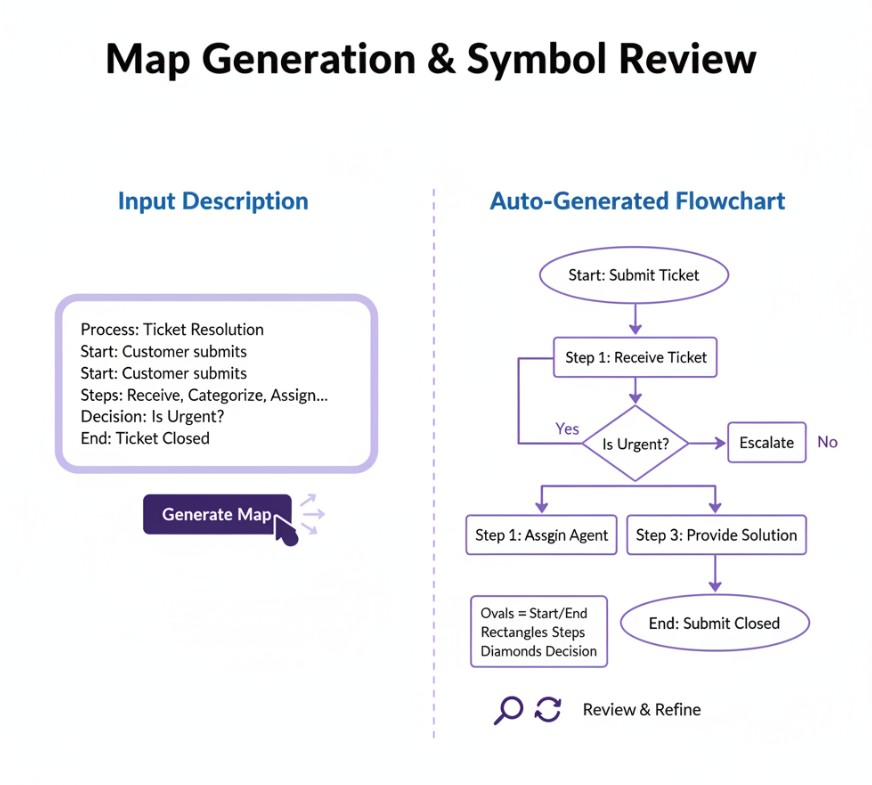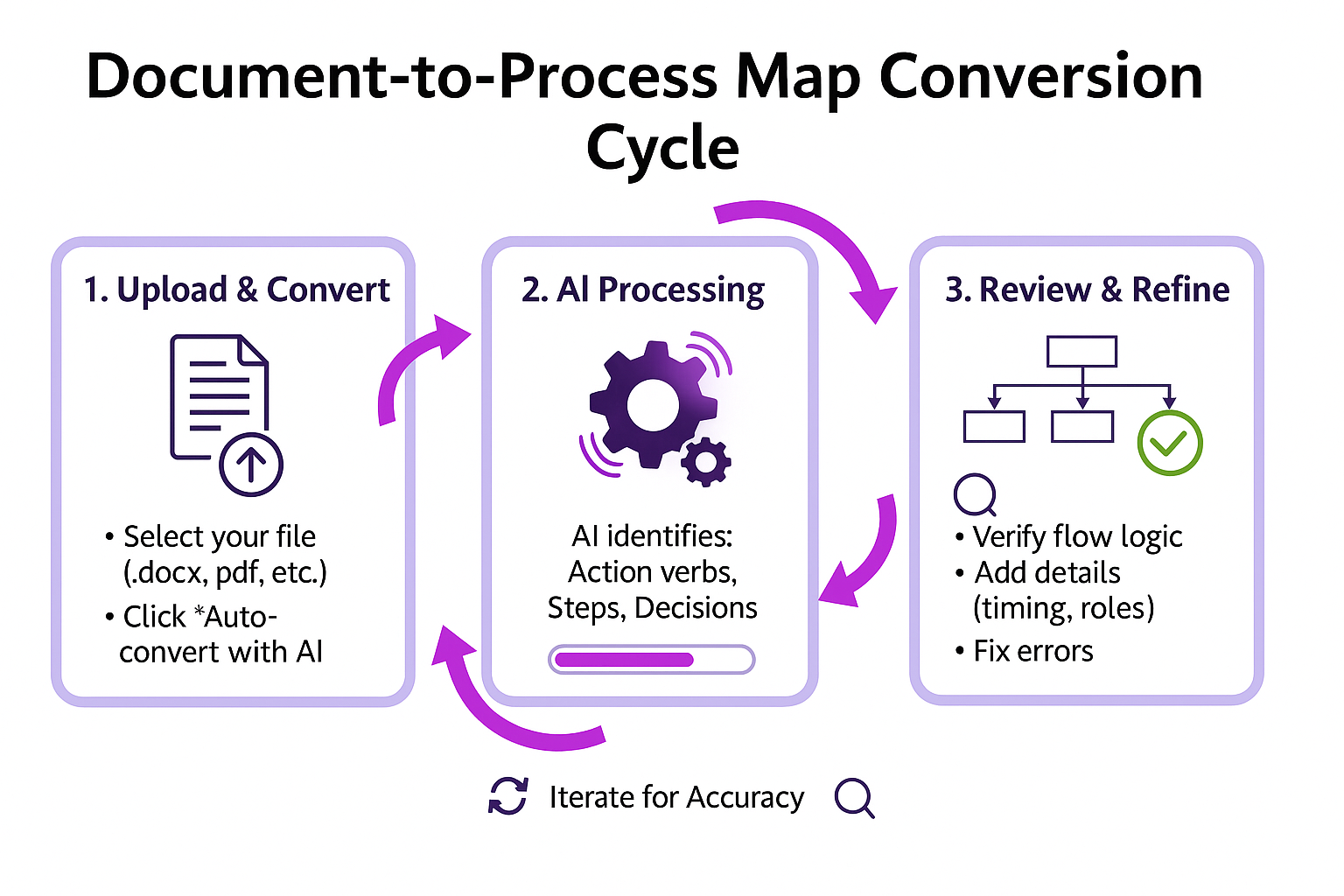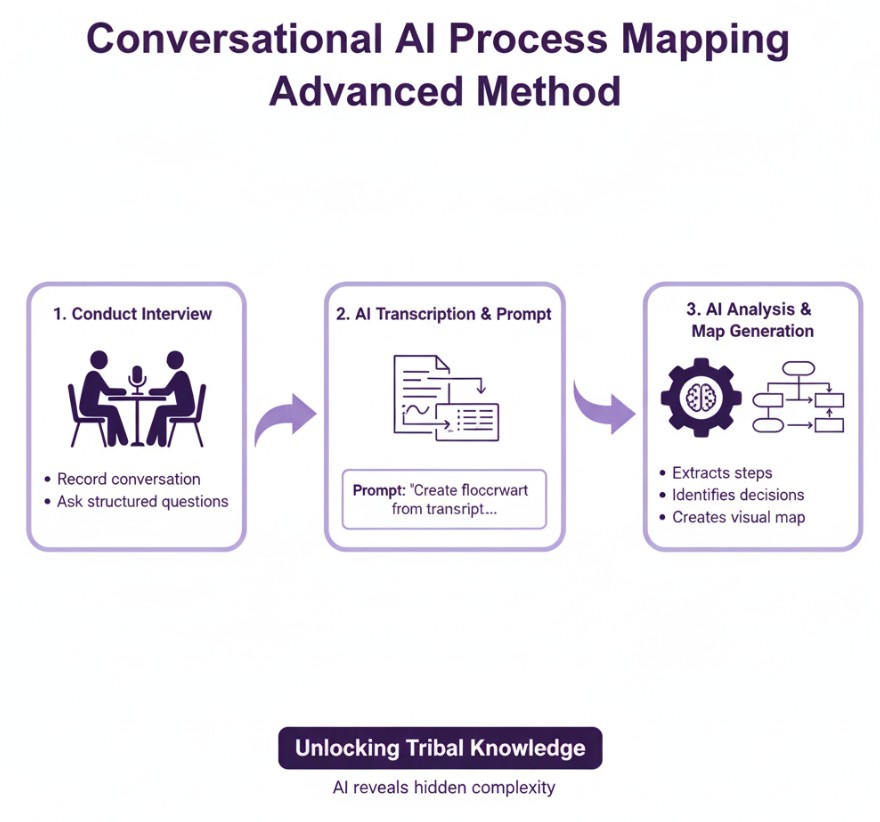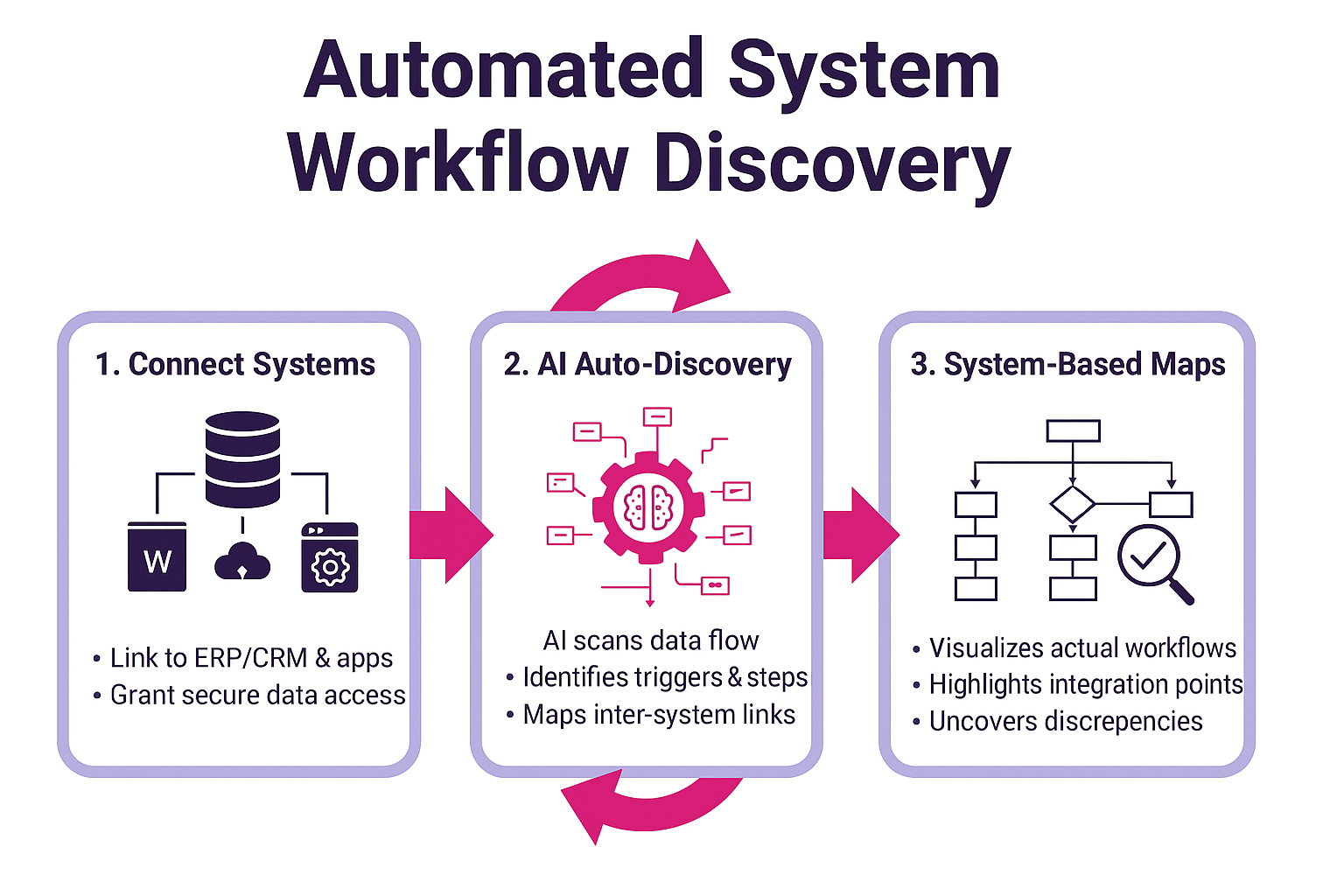Did you know the average office worker spends up to 19 days a year just documenting processes? That’s nearly a month lost to drawing boxes and arrows.
In this guide on how to use AI to easily create process maps, you’ll see how artificial intelligence can turn messy workflows into clear visuals in minutes, saving time, reducing errors, and making your processes smarter.
AI-powered process mapping: Four proven methods to build smarter workflows
Gone are the days of spending weeks manually drawing flowcharts and process diagrams. AI-powered process mapping tools can transform your written descriptions into professional visual maps in minutes, not hours.
Whether you're documenting existing workflows or designing new ones, artificial intelligence makes the entire process faster, more accurate, and surprisingly simple.
Let's dive into the four proven methods that deliver results immediately.
Method 1: Text-to-process map generation (most popular)
This approach transforms your written process descriptions into visual flowcharts using natural language processing. Most business professionals find this method intuitive since it mimics how we naturally explain processes to colleagues.

Choose your AI process mapping tool
Start by selecting a platform that matches your technical comfort level and budget requirements.
- Miro AI flowchart generator: Sign up → Access "Create with AI" → Select flowchart option
- Notion AI: Enable AI features → Go to database → Click "Generate flowchart with AI"
- Whimsical AI: Create account → Select "AI Text-to-Flowchart" → Start new diagram
- EdrawAI: Access process mapping tool → Click "AI Assist" button
Pro tip: Most platforms offer free trials, so test 2-3 options with the same process description to see which produces the clearest output for your specific needs.
Write your process description (exact format)
The quality of your input description directly determines the accuracy of your generated map. Follow this proven template structure for best results.
Template to follow:
- Process name: [Your process name]
- Start point: [What triggers this process]
- End point: [What completes this process]
- Main steps: [List 5-15 key actions in sequence]
- Decision points: [Where choices need to be made]
- Responsible parties: [Who does what]
Real example: Process name: Customer support ticket resolution Start point: Customer submits support ticket End point: Ticket closed and customer satisfied Main steps:
- Receive ticket in the system
- Categorize issue type
- Assign to the appropriate agent
- Research and diagnose the problem
- Provide a solution to the customer
- Verify customer satisfaction
- Close ticket and document resolution decision points:
- Is this urgent? (Yes → Escalate, No → Normal queue)
- Is the solution working? (Yes → Close, No → Escalate) Responsible parties: Support agent, Team lead, Technical specialist
The more specific details you provide, the more comprehensive your generated map will be. Include timing estimates, required resources, and potential exceptions where relevant.
Generate your initial map (exact process)
The actual map creation happens in seconds once you've prepared your description properly.
- Paste your description into the AI tool's input field
- Click "Generate" or "Create" (processing takes 10-30 seconds)
- Review the auto-generated symbols:
- Ovals = Start/End points
- Rectangles = Process steps
- Diamonds = Decision points
- Arrows = Flow direction
Don't worry if the first version isn't perfect – AI-generated maps typically require minor adjustments rather than complete rebuilds. The initial output gives you a solid foundation to refine.
Refine using AI suggestions
Modern AI tools offer interactive refinement capabilities that help you improve your map through conversational commands.
Specific commands to use:
- "Add more detail to step [number]"
- "Show alternative paths for [decision point]"
- "Include exception handling for [specific scenario]"
- "Add responsible roles to each step."
Example refinement session: After generating your initial customer support map, you might ask: "Add timing estimates to each step" or "Show what happens when a customer doesn't respond within 48 hours." The AI will automatically update your flowchart with these enhancements.
Validate and enhance
Quality assurance becomes much easier when AI handles the technical validation while you focus on business logic accuracy.
AI-powered validation features:
- Auto-check features: Most tools highlight incomplete connections
- Add timing estimates: Use AI to suggest realistic timeframes
- Include resources: Ask AI to identify needed tools/documents
- Error detection: AI will flag logical inconsistencies
Review each decision point to ensure all possible outcomes are represented. Missing pathways often become obvious when you see the visual representation.
Method 2: Document-to-process map conversion
Transform your existing written procedures, your project charter, and SOPs into visual process maps without starting from scratch. This method works particularly well for organizations with extensive documentation libraries.

Prepare your existing documentation
Clean, well-structured documents produce the most accurate conversions. Organize your materials before uploading for optimal results.
Supported formats:
- Word documents (.docx)
- PDF procedures
- Excel workflow sheets
- PowerPoint process slides
- Plain text procedures
Preparation tip: Documents with numbered steps, clear headers, and action-oriented language convert most successfully. Remove unnecessary formatting and focus on process content rather than design elements.
Upload and convert (specific instructions)
Each platform handles document conversion differently, but the core process remains surprisingly straightforward.
Platform-specific steps:
- In ProcessPro SmartFlow: Click "Import Document" → Select file → Choose "Auto-convert to process map"
- In Notion AI: Upload to workspace → Select text → Click "Convert to flowchart with AI"
- In Kroolo: Go to Process section → "Import from file" → Select auto-mapping option
The conversion typically takes 30-60 seconds, depending on document length and complexity. Longer documents may require additional processing time, but rarely exceed two minutes.
AI processing and cleanup
The AI automatically identifies process elements from your documentation, but human verification ensures accuracy and completeness.
What AI automatically identifies:
- Action verbs, sequence indicators, decision words
- Manual verification needed: Check for missed steps, validate flow logic
- Enhancement prompts: "Expand step details," "Add decision criteria," "Include error handling"
Review the generated map alongside your original document to catch any interpretation errors or missed nuances that only human judgment can identify.
Method 3: Interview-to-map generation (advanced)
Convert stakeholder conversations into structured process maps using AI transcription and analysis capabilities. This method captures tribal knowledge that exists only in people's heads.

Conduct process interviews
Structured interviews combined with hr project management software provide the richest source material for comprehensive process maps. Prepare your questions in advance to ensure complete coverage.
Record or transcribe stakeholder interviews using these questions:
- "Walk me through this process from start to finish."
- "What happens if [exception scenario]?"
- "Who else gets involved and when?"
- "What tools/systems do you use?"
Interview tip: Allow 30-45 minutes per interview and focus on one specific process rather than trying to cover multiple workflows in a single session.
Feed transcript to AI
Transform conversational descriptions into structured process documentation using specific AI prompts designed for process extraction.
Prompt template: "Create a process map from this interview transcript about [process name]. Identify all steps, decision points, and responsible parties. Format as a flowchart with standard BPMN symbols." [Paste transcript]
The AI will analyze the conversational flow and extract formal process steps while maintaining the original context and nuances shared during the interview.
AI analysis and map generation
Advanced natural language processing identifies implicit process elements that might not be obvious in casual conversation.
What happens during AI analysis:
- AI extracts process steps from conversational text
- Identifies implied decision points and workflows
- Creates a visual representation with proper symbols
- Suggests missing elements based on process type
This method often reveals hidden complexity and edge cases that stakeholders mention casually but might forget in written documentation.
Method 4: System integration mapping
Connect directly to your existing business systems and let AI automatically discover your current workflows. This approach provides the most accurate representation of how work actually flows through your organization.

Connect to your business systems
Modern AI tools can integrate with popular business platforms to extract real workflow data rather than relying on how people think processes work.
Tools with integration capabilities:
- Kroolo: Connect ERP/CRM → Auto-discover workflows
- ProcessPro: Link to project management → Extract process data
- Notion AI: Sync with existing workflows → Generate maps
Security note: Only grant necessary permissions and review data access policies before connecting sensitive business systems to external AI tools.
Auto-discovery process
The AI scans your connected systems to identify actual workflow patterns based on real user behavior and data flows.
What happens during auto-discovery:
- Grant tool access to your systems
- AI scans for workflow patterns and data flows
- Identifies process triggers and completion points
- Maps inter-system dependencies
This approach often reveals discrepancies between documented procedures and actual practice, providing valuable insights for process improvement.
Generate system-based maps
System-generated maps show how work actually flows through your organization rather than how it's supposed to flow according to documentation.
What gets mapped:
- AI creates maps showing data flow between systems
- Includes user touchpoints and automated processes
- Highlights integration points and potential failures
These maps become particularly valuable for digital transformation initiatives and system optimization projects.
Quality assurance checklist (AI-assisted)
Before finalizing any AI-generated process map, run through this comprehensive validation to ensure accuracy and completeness.
Use AI to verify:
- All process steps have clear owners
- Decision points include all possible outcomes
- Start and end points are clearly defined
- No orphaned or disconnected elements
- Timing estimates are realistic
- Exception handling is included
Final validation tip: Share the completed map with actual process participants, using a stakeholder engagement plan template, for real-world verification before implementing or sharing organization-wide.
Export and implementation options
Transform your completed AI-generated maps into actionable business tools through various export and integration options.
Standard export formats:
- PDF: For documentation and sharing
- PNG/SVG: For presentations and wikis
- BPMN XML: For technical implementation
- Excel: For detailed analysis and metrics
Integration options:
- Embed in knowledge bases (Confluence, Notion)
- Share via collaborative platforms (Teams, Slack)
- Import into workflow automation tools
- Link to training materials and SOPs
Choose export formats based on your intended use case; PDFs work well for training materials while BPMN XML enables technical implementation in workflow automation platforms.
AI process mapping transforms weeks of manual work into minutes of automated creation, making professional workflow documentation accessible to everyone.
Bring clarity to processes with automated AI diagrams
AI has made process mapping faster, smarter, and more accurate than ever. Whether you start with text, documents, interviews, or system data, AI transforms messy workflows into clear, professional diagrams in minutes. The key is to refine with prompts, validate outputs, and integrate maps into daily operations.
By embracing AI-powered process maps, teams save time, reduce errors, and keep everyone aligned, turning complex processes into actionable clarity.


%20(1).jpg)
_light%201.png)





